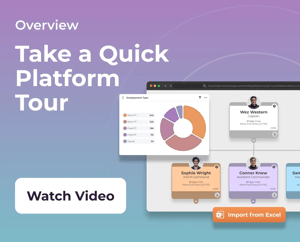Talent acquisition, full employee LifeCycle, Org Chart, performance, surveys...
Introduction of HRIS
Human Resources Information System
What is HRIS?
Definition: A human resource information system (HRIS) is an adaptable software solution designed to help HR teams manage everything from employee and position data, to workflows and processes. It covers the full spectrum of the employee lifecycle, allowing you to efficiently carry out recruitment, onboarding, change of employee conditions, and offboarding among other crucial functions. It is the go-to tool for organizations looking to enhance collaboration between managers and HR teams, ensure data accuracy to hold against employee records, and grant HR teams more time to focus on strategic initiatives.
Evolution of HRIS
Back in the 1960s, an HRIS was essentially a computer-based system for automating some manual payroll functions and not much more. However, over the years, as HR departments have transformed from primarily administrative roles to more strategic contributors, HRIS has evolved into a tool that supports management decision-making.
This brings us to today where it has transformed into an all-in-one online hub encompassing thousands of functions, including recruitment, onboarding, offboarding, reference checking, compliance checks, benefits management, organizational charts, and self-service applications. They give managers the autonomy to perform tasks independently rather than relying on HR and experiencing delays. Meanwhile, employees can use it to directly handle actions like submitting leave requests without the need to contact HR. It’s a true game-changer for workplace efficiency.
Importance of HRIS in Modern Organizations
An HRIS is an essential resource for modern organizations. It empowers teams to optimise their HR operations, strengthening compliance, boosting efficiency, and enhancing the overall experience for candidates, employees, managers, and executives. By using an HRIS to automate time-consuming manual tasks and deliver a seamless experience for all stakeholders, organisations can ensure operational efficiency while avoiding the hefty costs associated with administrative burdens, candidate drop-off, and potential legal complications.
HRIS vs HRMS vs HCM - What are the differences?
Human Resources Information System (HRIS) serves as a central hub for managing all HR-related data and processes such as employee and position information, remuneration, organizational charts, recruitment and onboarding, change of conditions, offboarding, and more.
Human Resources Management System (HRMS) is traditionally known to build upon HRIS software by introducing management and automation features. However, in this day and age, it is often used interchangeably with the term HRIS as both encompass these capabilities.
Human Capital Management (HCM) offers an even more comprehensive HR solution that extends the capabilities of HRMS and HRIS systems to integrate tools aimed at macro-level processes such as employee engagement and career development.
Future of Human Resources Information System (HRIS)
As the responsibilities of HR teams continue to evolve, HRIS platforms are transforming from their traditional data-centric role into employee-centered systems. With modules such as employee self-service (ESS) which lets team members take control of their own HR needs, and custom requisition workflows that make approvals a breeze for managers, HRIS platforms are becoming essential in achieving productivity and allowing HR teams to focus on more strategic tasks.
HRIS Selection and Implementation
Factors to Consider When Choosing an HRIS
When choosing an HRIS, make sure it's fully customisable, compliance-assured, comprehensive, and effective in facilitating seamless communication between executives, managers, employees, and your HR team. And as the needs of organisations are always changing, it’s best to get set up with an HRIS that covers every aspect of HR so that you’re prepared for anything that comes your way – from the entire employee lifecycle, all the way to payroll integration and access control.
The HRIS Implementation Process
When it comes to implementing an HRIS, timelines can vary from weeks to months. But here's the good news: some HRIS providers such as Martian Logic offer a free plan which allows you to test and set up the platform yourself. With self-admin capabilities and powerful data import tools that allow you to swiftly import all your employee data, you can get started with the platform instantly. However, you're not alone in the journey – for a smooth implementation process and to configure the platform to best suit your needs, you can always collaborate with your HRIS provider's implementation team for a seamless experience.
Common Implementation Challenges and Solutions
- Training employees & managers to use a new HRIS
When it comes to training employees and managers to use a new HRIS, it can sometimes be an overwhelming and confusing process. To overcome this, it's best to actively involve managers during implementation or provide ample time for learning the system. This will pave the way for a smoother transition and ensure the HRIS integrates seamlessly and successfully into your organisation. - Configuring HRIS for optimal use
Configuring an HRIS for peak performance can sometimes feel like finding your way around an unfamiliar place due to the thousands of features it comes with. However, there are two effective approaches to streamline this process. Firstly, you can seek support from your chosen HRIS provider, who can assist in system configuration, including setting up alerts, compliance, and recruitment processes. Alternatively, you may choose to collaborate with the client success specialists from your HRIS provider. Together, you can thoroughly explore the platform and gain a deeper understanding of its features and functionalities. - Ensuring data security
Ensuring data security is crucial and the best way to guarantee the safety and security of your HR data is by selecting an HRIS with robust data security and compliance measures. We recommend leveraging the access control feature to make sure that only the authorised employees have access to sensitive information.
HRIS Modules and Features
Employee Information Management
HRIS platforms serve as both a data collection tool and HR database, allowing managers to analyse the most up-to-date versions of employee records at their convenience. HRIS solutions also streamline processes within the employee lifecycle with automations and features such as custom approval workflows. This multi-functionality is key in helping organisations effortlessly manage every aspect of employee information, from remuneration details to work type, and beyond.
[Martian Logic employee database]
Payroll and Benefits Administration
Many HRIS platforms come with integrated payroll systems, allowing you to leverage the strengths of both. By having top vendors in their respective fields seamlessly working together, you can ensure reliable and accurate payroll processing without depending solely on a single big system. This ensures that every employee receives their compensation promptly and accurately from the day they join your organisation. It's all about delivering a comprehensive solution that works best for you.
Time and Attendance Tracking
Using an HRIS for time and attendance tracking is essential when overseeing employees with various work engagements, including full-time, hourly, and contracted personnel. It’s also helpful for monitoring overtime hours, as HRIS platforms equip HR teams with the necessary tools to stay organised and ensure precise timekeeping for proper compensation.
Performance Management
HRIS systems often include performance management features, allowing HR teams to manage employee performance reviews and enabling managers to assess performance metrics. This data helps highlight areas for improvement or regression, and determine which employees might benefit from additional support or resources to enhance their performance.
Recruitment and Applicant Tracking
HRIS platforms with Applicant Tracking Systems (ATS) or recruitment modules help to streamline the hiring process. This ensures that all applicant details are collected and stored in one convenient platform, allowing you to manage and progress candidates to various stages of the recruitment process with accuracy, compliance, and efficiency.
Training and Development
Some HRIS systems automate and streamline the process of creating training and development programs. Managers and HR teams can use the platform to customise learning materials, design tests, monitor training progress, and assess development performance.
Reporting and Analytics
HRIS platforms include reporting and data analysis features that provide access to a comprehensive employee dashboard and auto-generated reports to help inform HR strategy. This lets HR teams review all employee data from one convenient platform to pinpoint key performance indicators and metrics such as training costs, employee productivity, job satisfaction, and turnover rates. These insights help to provide valuable guidance for enhancing HR processes.
[Martian Logic Employee Dashboard]
HRIS ROI and Value
Measuring the Return on Investment (ROI)
When you embrace a modern and slick HRIS, the rewards are truly remarkable in the long run. This dynamic system offers a fantastic return on investment, thanks to a range of key advantages. By reducing compliance risks and offering automations to keep candidates, employees, managers, and executives engaged, it simplifies the recruitment and onboarding processes while enhancing overall HR efficiency. This not only helps reduce candidate drop-off, which eliminates potential costs of unfilled positions, but also boosts overall productivity. Most importantly, it accommodates the precious time of both managers and HR teams, giving each the tools they need to manage HR tasks effortlessly and accurately.
Demonstrating HRIS Value to Leadership
HRIS demonstrates its value to leadership by making HR management easier for everyone. It guarantees role-specific compliance and ensures that all employee records are always up-to-date and ready to access when needed. Plus, executives and managers can actively engage in HR processes such as recruitment as HRIS systems facilitate transparency and collaboration at every stage (from job posting, all the way to onboarding).
Continuous Improvement in HRIS Utilization
HRIS systems never stop improving as they continue to adapt based on the evolving needs of organisations and HR teams. To keep up-to-date with HR trends and requirements, they are constantly introducing new features and user-friendly interfaces, ensuring it's always the optimal tool for streamlining HR tasks.
HRIS Trends and Future Developments
AI and Machine Learning in HRIS
AI and machine learning are reshaping HRIS and HCM, making HR tasks smarter. Think about recruitment – AI-driven HRIS systems can dive into large amounts of data to find top talent, figure out if they're a good fit, and even predict how well they'd do in your organisation. These platforms can also utilise video responses to conduct psychometric testing on candidates, yielding insights into the big five personality traits to better inform hiring decisions. And it doesn’t stop there. AI streamlines administrative duties, such as data entry and paperwork, allowing it to handle the heavy lifting with precision. This liberates HR teams, affording them more time for strategic tasks.
[Martian Logic AI-Based Psychometric Testing]
HRIS in the Gig Economy
In the gig economy, where temporary and freelance work is the norm, HRIS plays a crucial role. It provides an accurate and up-to-date view of each employee's data, without you having to worry about duplicates or conflicting information. And if you set it up for the long haul, HRIS becomes an all-in-one tool that is customised and tailored to fit your organisations needs perfectly. This flexibility keeps an HRIS at the top of its game, no matter how diverse the gig economy gets.


